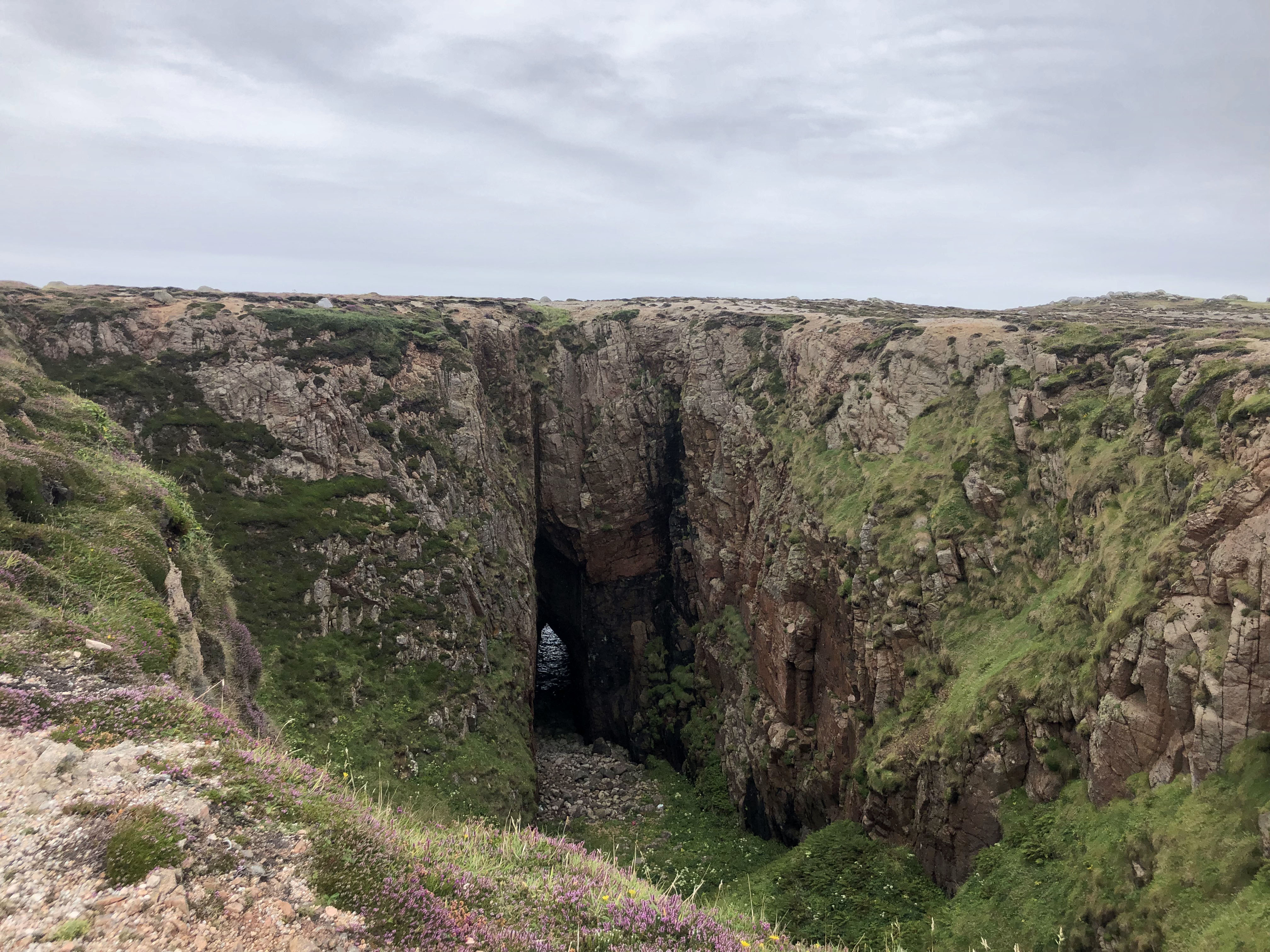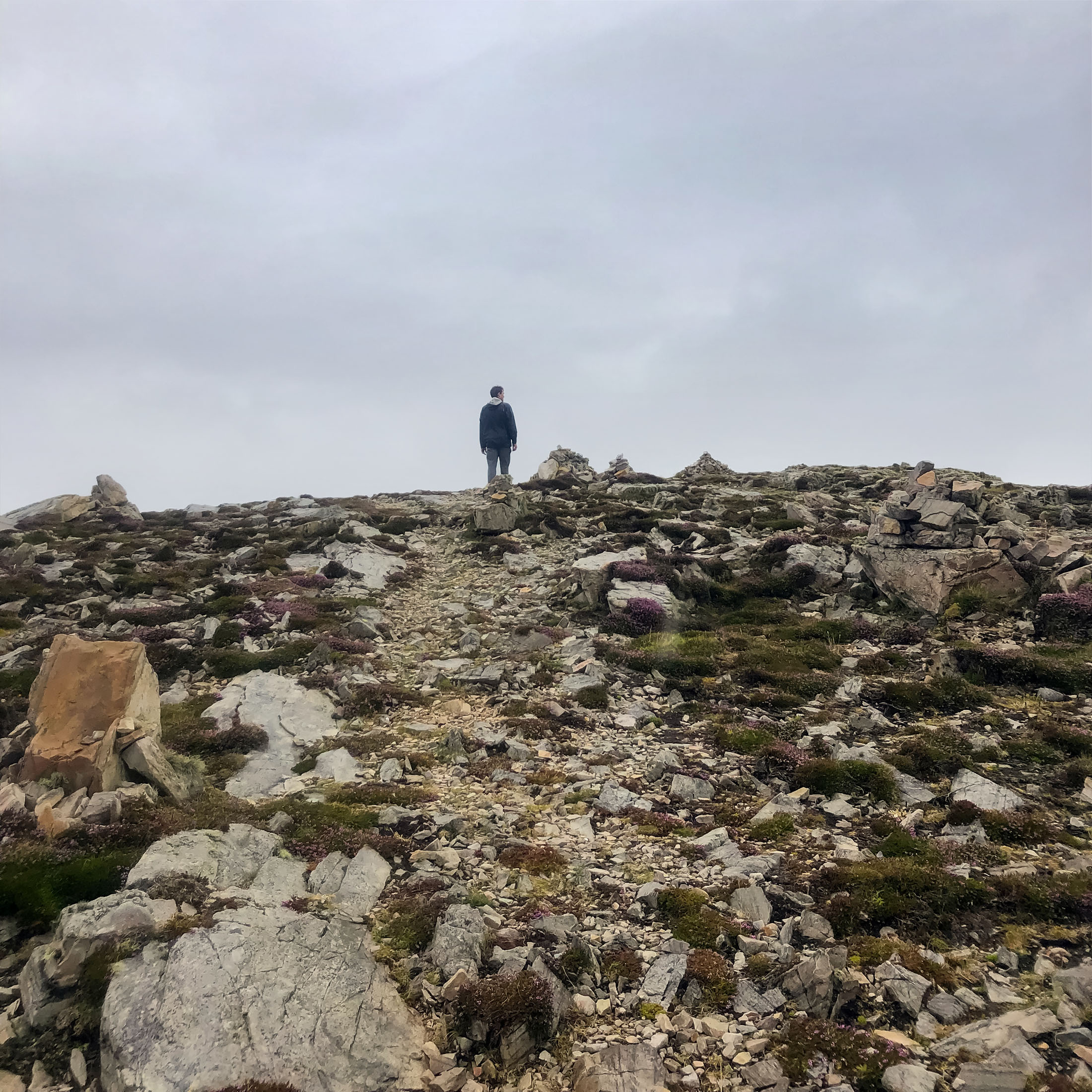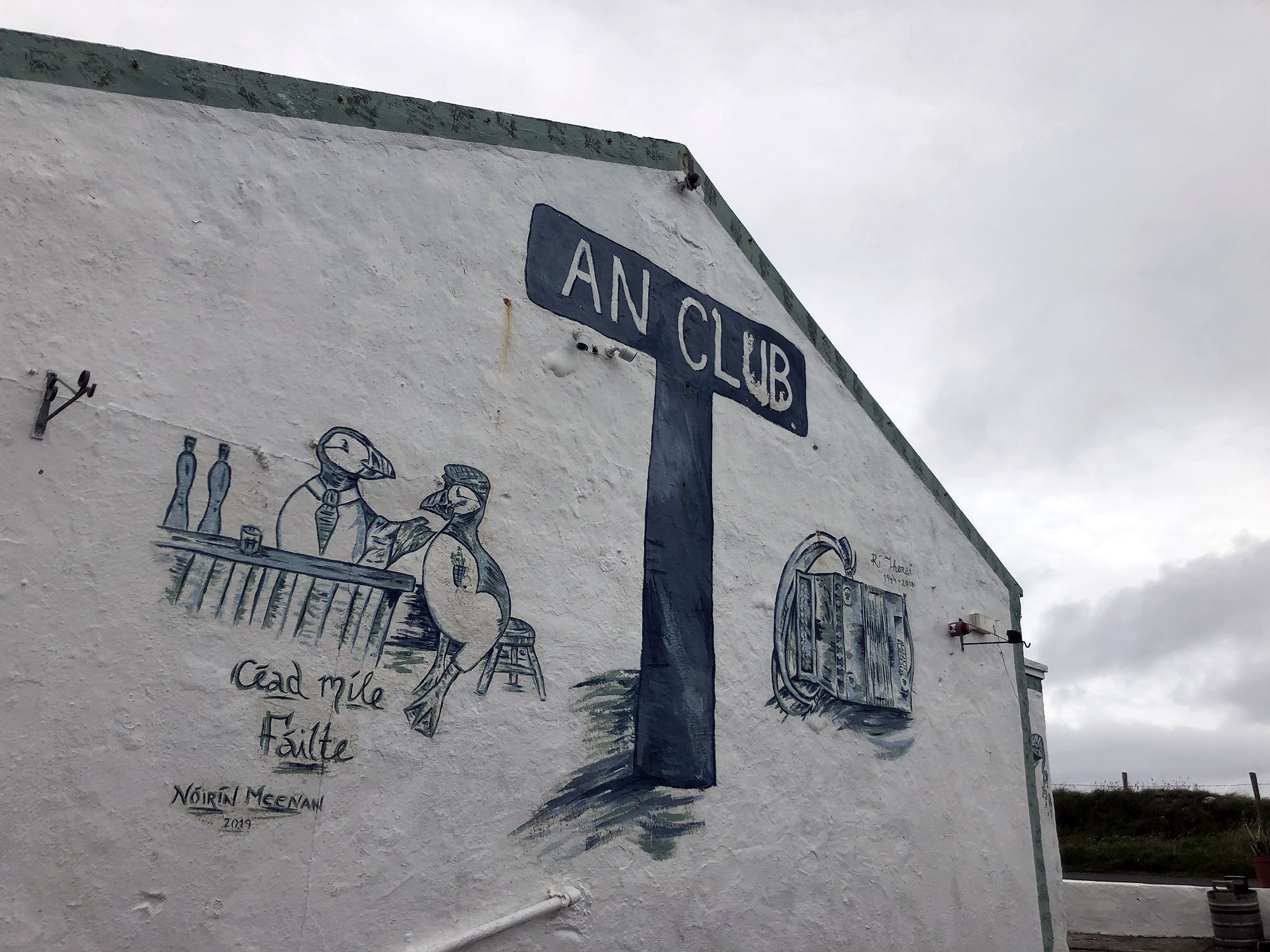Dispatch 2

By Kyra Morris
Once the flat-bottomed ferry passes beyond the jetty at Magheraroarty, it begins to pitch violently. As the mainland recedes, the waves grow. The ferry climbs up and then careens down the steep gulfs between the walls of water—all the while tossing side to side. I am too terrified to guess how high the seas are. My eyes are fixed on the ferry’s upper deck where my bicycle is strapped to a railing with a single bungee cord. In the bike’s paniers are all the belongings I have with me, including my passport. It does not reassure me that the boat has no keel. Nor does it reassure me to hear the captain cut the engine as we crest each mountain of water, each mound of the Irish Sea. It is slightly comforting that, even as many passengers are busy emptying the contents of their stomachs into plastic bags, one man in a wool cap stands steadfastly at the stern, looking out at the heaving water as if nothing is out of the ordinary. In the reusable shopping bag slung over his shoulder, he carries a small dog.
Depending on which source you read or whom you ask, the name means “Island of the Pirates,” “Island of the Tower,” or “Funerals Island."
We are headed to Tory Island, or Toraigh in Gaelic, which sits nine miles off the northwest coast of Ireland. It’s the country’s most remote inhabited landmass and one of its most dramatic—much of its coastline is cliff. Tory’s remoteness has made it the site of cultural and ecological anomalies. It is the only place in Ireland that still has a king, although the king’s responsibilities are more like those of a modern-day mayor. (My visit, unfortunately, took place during an interregnum and so I did not get to witness this peculiarity of life on Tory). The island also boasts its own music and painting traditions, its own breed of cattle (now extinct), its own cursing stone (used to induce shipwrecks), its own magical clay (said to drive away rats, prevent potato blight, and calm rough waters), and its own curses (eighteen) and proverbs (sixty-one). Today, Tory is also an important breeding ground for endangered birds like Corncrakes and Puffins as well as for myths about the origin of its own name. Depending on which source you read or whom you ask, the name means “Island of the Pirates,” “Island of the Tower,” or “Funerals Island.”

Tory’s vertiginous cliffs have legends of their own. They are responsible for numerous shipwrecks, from the 1884 wreck of the HMS Wasp (a fortuitous one for the islands’ residents because the ship had come to collect rent payments) to the 2003 wreck of a reality TV crew and its contestants. Myth has it that Tory was once the fortress for a race of giants called the Fomorians, and it’s easy to see why. It’s more difficult to see why the island would have been a destination for Saint Colmcille—a sixth-century Irish monk most famous for founding the monasteries at Kells in County Meath, Ireland, and on Iona, an island off the western coast of Scotland. But Colmcille also founded a monastery on Tory with a central church and seven small chapels. What may have been the monastery’s bell tower—made of blocks of granite larger than my head—survives largely intact.
Colmcille’s tower is the first thing I see when I step off the ferry. My bicycle, by some miracle, is at my side and not at the bottom of the Irish Sea. I wheel it past the tower, imagining Colmcille’s passage to Tory. He would have made his crossing in a small boat or currach constructed of an oak-tanned ox hide stretched over a wooden or wicker frame—a frail craft compared with the metal-hulled ferry I crossed in. But perhaps Colmcille made his voyage in calmer seas. According to a seventh-century hagiography, Colmcille “could rule the winds and the waves” and provide sailors with favorable weather. One legend has it that God allowed Colmcille to walk across the water to Tory. Another maintains that he landed in a currach after being repulsed three times by unfriendly Danes. But even if he was blessed with an easy voyage, what drew the saint out to this barren island, this mound of granite not even half a mile wide?
For the peregrini, these wild, uncompromising places were portals to the divine.
Years before my visit to Tory, I read Robert Macfarlane’s account of a voyage out to Ynys Enlli, a similarly remote island off the coast of Scotland. It too was a destination for Celtic Christian peregrini—monks who left their homelands for an ascetic life of chosen exile in what Macfarlane calls remote “edgelands.” At these fringes of the inhabited world, where the forces of wind, water, and rock dominate, the peregrini founded monasteries. Even today, such places are difficult to reach. One of the peregrini’s destinations, Skellig Michael, is a saw-toothed, knife-edged crag of slate nine miles off Ireland’s southwest coast. The approach to the hermitage there is so precipitous that the site is usually closed to visitors. For the peregrini, these wild, uncompromising places were portals to the divine.
My legs still uncertain of solid ground from the ferry ride to Tory, I make my way from the harbor flanked by Colmcille’s tower to the island’s one hotel. It is only noon, but the hotel pub is full. There are a few visiting bird watchers, unmistakable in their synthetic fabrics and sensible walking shoes. Others clearly live here. At the bar, Gaelic is the primary language. Near the double doors at the entrance is a family—grandmother, daughter, and grown granddaughter. The grandmother sips a glass of Bailey’s and ice. At the far end of the room, next to the fireplace, a man who came over with me on the ferry is unpacking his uilleann pipes. I order a tea and try to identify the sea-creatures in the stained-glass panes of the double doors. The man with the uilleann pipes begins playing and sometimes a fiddle joins him. Each tune is distinct, but partially improvised—the fiddle plays off the pipes. There is no set list, no sheet music.
The hum of conversation continues under the whine of the pipes. They won’t be running the last ferry this evening, a man at the bar tells me. When the waves reach four meters (thirteen feet), they stop the service. I’m about to ask what it’s like in the winter, how often the boat runs, when the room goes silent. Wind and rain lash at the building. A boy, maybe eight years old, begins singing in Gaelic. I understand nothing except that this song is a story, a tragic one, and that the silence of the audience marks it as somehow sacred. Other ballads follow, all in Gaelic and all without instruments, until, around four o’clock, the crowd finally disperses. Wind and rain lash at the building.
I leave then too, venturing out to meet the flung spray. I follow the paved road past the few houses that constitute the town and the outlying houses beyond, continuing on as pavement gives way to gravel and then to a path that is merely a track where rock shows through the thin soil. I head for the island’s northeastern edge and Tor Mór, its highest point. The turret of rock rises more than two hundred feet out of the sea and is connected to the island by a rocky spine only inches across at its top. It was on this rocky turret that Baylor, the last king of a race of mythic giants, supposedly imprisoned his daughter so that her offspring would not overthrow him. Baylor couldn’t have chosen a better spot (although it did not prevent his demise). This is a wild place. The land is barren except for two species of purple heather and mosses that look like stars. In some places, the wind must be too much even for the hearty heather because there are patches of dark soil where the heather’s white roots lie exposed, flattened in the direction of the prevailing westerlies. Where even the heather has worn away completely—the effect of both wind and turf cutting—the island seems a moonscape.

As I approach the island’s edge, the cliffs appear as a line against the sky separating brown-grey from blue-grey. But as I get closer, I see that this furthest edge had distracted me from the edges to my right and left—dark shapes that eat into the island at irregular intervals. I would not want to walk here in a fog.
Soon, I find myself facing a narrow saddle where the island contracts to a mere twenty feet wide. I do not look over the edge, but I can tell it is a sheer drop to the sea on either side. I begin to imagine what would happen if I tripped on a loose stone, a wet patch of moss. I do not cross the saddle. Instead, I approach an edge from which retreat would be easier and stand listening to the waves explode into spray at the foot of the cliffs. The crash-and-hiss is both comforting and terrifying—comforting in its constancy, terrifying in its force. I can spend only a few minutes at the edge before I step away slowly and head for the cluster of white shapes that is town.
But perhaps it was not simply the wildness of the place that drew him there, but the simultaneous hymn and dirge of its edges.
Months later, long after I’ve left Tory, I read a sixth-century poem attributed to Saint Colmcille that reminds me of that edge. It’s a poem of longing for his native Ireland, but specifically for its shorelines, its waters: “To see the waves, crest on crest/of the great shining ocean, composing a hymn to the creator, without rest.” The poem keeps building its catalog of sea-imagery, its litany of all Colmcille longs for: “To hear the whisper of small waves/against the rock, that endless sea-/sound, like keening over graves.” A hymn to the creator and keening over graves—both ethereal and earthly, deathless and mortal. One legend has it that bringing Christianity to desolate Tory offered Colmcille honor, another that it offered him contemplation. But perhaps it was not simply the wildness of the place that drew him there, but the simultaneous hymn and dirge of its edges.
When I return from the cliff-edge and walk through the stained-glass double doors of the hotel pub, it is already dinner time. The waitress tells me this is a quiet night. Last night was the party. Tory is famous for its parties—everywhere I went on the mainland, someone would tell me that I if was going to Tory I should expect to go to bed at sunrise. It may be a quiet night, but I decide to venture out to Tory’s second pub—called simply “An Club” (The Club). There must be fifteen people huddled at the bar or in booths, not a bad showing for a Sunday night on an island with a population of 141. A ten-year-old girl carefully counts out her change to buy a Coca-Cola, then practices her cartwheels while her mom looks on. At the bar is a group of men who don’t seem to need to say much to each other. They speak in spurts—only, it seems, when there is something to say.

Around midnight—long after the last bar in my town in New Jersey would be closed—someone begins playing guitar. He’s playing American classics, belting “Johnny Be Good.” Then another guitar joins him and the music and the language changes. Now a whole booth is singing along in a language I can’t identify. On my way out, I ask the bartender, who tells me, “Ukrainian.”
Walking back to the Tory Hotel in the dark, I listen to the sea hymn that is also a dirge. The bar’s enclosure of light and music has vanished—replaced by whipping wind, black night, roaring rocks. There is, I realize, another reason to seek out remote edges—a reason that has nothing to do with asceticism, or faith, or even wildness. There is the music of wind and waves, but there is also the human music that can hold them at bay, however briefly. Within the enclosure of that music, Tory becomes a center, not simply a wild edge.
